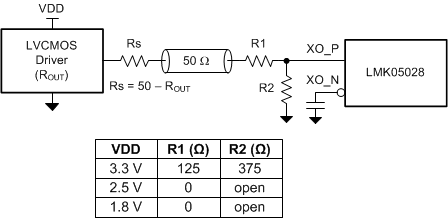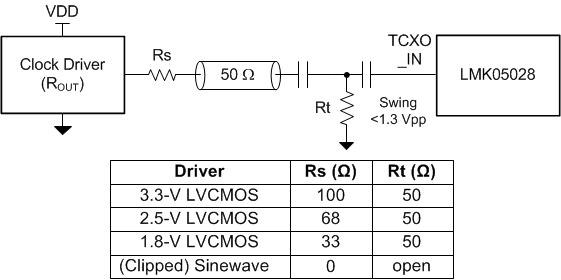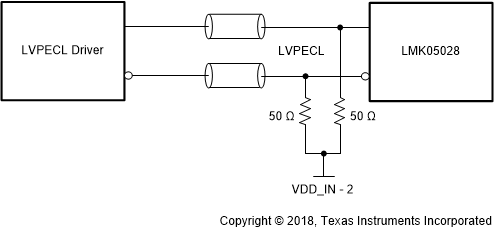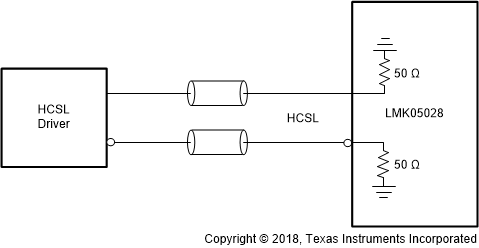ZHCSHN9A February 2018 – April 2018 LMK05028
PRODUCTION DATA.
- 1 特性
- 2 应用
- 3 说明
- 4 修订历史记录
- 5 说明 (续)
- 6 Pin Configuration and Functions
- 7 Specifications
- 8 Parameter Measurement Information
-
9 Detailed Description
- 9.1 Overview
- 9.2 Functional Block Diagrams
- 9.3
Feature Description
- 9.3.1 Oscillator Input (XO_P/N)
- 9.3.2 TCXO/OCXO Input (TCXO_IN)
- 9.3.3 Reference Inputs (INx_P/N)
- 9.3.4 Clock Input Interfacing and Termination
- 9.3.5 Reference Input Mux Selection
- 9.3.6 Hitless Switching
- 9.3.7 Gapped Clock Support on Reference Inputs
- 9.3.8 Input Clock and PLL Monitoring, Status, and Interrupts
- 9.3.9
PLL Channels
- 9.3.9.1 PLL Frequency Relationships
- 9.3.9.2 Analog PLL (APLL)
- 9.3.9.3 APLL XO Doubler
- 9.3.9.4 APLL Phase Frequency Detector (PFD) and Charge Pump
- 9.3.9.5 APLL Loop Filter
- 9.3.9.6 APLL Voltage Controlled Oscillator (VCO)
- 9.3.9.7 APLL VCO Post-Dividers (P1, P2)
- 9.3.9.8 APLL Fractional N Divider (N) With SDM
- 9.3.9.9 REF-DPLL Reference Divider (R)
- 9.3.9.10 TCXO/OCXO Input Doubler and M Divider
- 9.3.9.11 TCXO Mux
- 9.3.9.12 REF-DPLL and TCXO-DPLL Time-to-Digital Converter (TDC)
- 9.3.9.13 REF-DPLL and TCXO-DPLL Loop Filter
- 9.3.9.14 REF-DPLL and TCXO-DPLL Feedback Dividers
- 9.3.10 Output Clock Distribution
- 9.3.11 Output Channel Muxes
- 9.3.12 Output Dividers
- 9.3.13 Clock Outputs (OUTx_P/N)
- 9.3.14 Glitchless Output Clock Start-Up
- 9.3.15 Clock Output Interfacing and Termination
- 9.3.16 Output Synchronization (SYNC)
- 9.3.17 Zero-Delay Mode (ZDM) Configuration
- 9.3.18 PLL Cascading With Internal VCO Loopback
- 9.4 Device Functional Modes
- 9.5 Programming
- 9.6 Register Maps
- 10Application and Implementation
- 11Power Supply Recommendations
- 12Layout
- 13器件和文档支持
- 14机械、封装和可订购信息
9.3.4 Clock Input Interfacing and Termination
Figure 27 through Figure 34 show the recommended input interfacing and termination circuits. Unused clock inputs can be left floating or pulled down.
 Figure 27. Single-Ended LVCMOS to XO Input (XO_P)
Figure 27. Single-Ended LVCMOS to XO Input (XO_P)  Figure 28. Single-Ended LVCMOS or Sinewave to TCXO Input (TCXO_IN)
Figure 28. Single-Ended LVCMOS or Sinewave to TCXO Input (TCXO_IN)  Figure 29. Single-Ended LVCMOS (1.8, 2.5, 3.3 V) to Reference (INx_P)
Figure 29. Single-Ended LVCMOS (1.8, 2.5, 3.3 V) to Reference (INx_P)  Figure 30. DC-Coupled LVPECL to Reference (INx) or XO Inputs
Figure 30. DC-Coupled LVPECL to Reference (INx) or XO Inputs  Figure 31. DC-Coupled LVDS to Reference (INx) or XO Inputs
Figure 31. DC-Coupled LVDS to Reference (INx) or XO Inputs  Figure 32. DC-Coupled CML (Source Terminated) to Reference (INx) or XO Inputs
Figure 32. DC-Coupled CML (Source Terminated) to Reference (INx) or XO Inputs  Figure 33. HCSL (Load Terminated) to Reference (INx) or XO Inputs
Figure 33. HCSL (Load Terminated) to Reference (INx) or XO Inputs  Figure 34. AC-Coupled Differential to Reference (INx) or XO Inputs
Figure 34. AC-Coupled Differential to Reference (INx) or XO Inputs